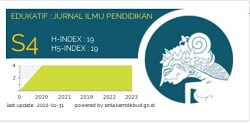An Analysis of Library Management System Development in South Sulawesi
Abstract
Keywords
Full Text:
PDFReferences
Akbar, A. K., & Azwar, M. (2018). The Implementation of Portal Union Catalog Server Sulsellib Based On Senayan Library Management Systems (SLiMS). Pustakaloka, 10(1), 19–38.
Bailey, A. A., Pentina, I., Mishra, A. S., & Ben Mimoun, M. S. (2017). Mobile payments adoption by US consumers: An extended TAM. International Journal of Retail & Distribution Management, 45(6), 626–640.
Creswell, J. W. (2014). Research design: Qualitative, quantitative, and mixed methods approaches (4th ed). SAGE Publications.
Dennison, L. (2011). Small and Open Source: Decisions and Implementation of an Open Source Integrated Library System in a Small Private College. Georgia Library Quarterly, 48(2).
Dewi, E. G. A., Dewi, P. A. C., & Sudiatmika, I. B. K. (2021). Pengaruh Perpustakaan Digital dalam Meningkatkan Minat Membaca Mahasiswa. EDUKATIF: Jurnal Ilmu Pendidikan, 3(6), 5024–5034.
Engard, N. C. (2010). Practical Open Source Software for Libraries. In Practical Open Source Software for Libraries. Chandos Publishing. https://doi.org/10.1533/9781780630434
Fachrial, E. (2020). Manajemen Lulusan Berbasis Pembelajaran Online (Daring). Pena Persada.
Haryono, H. (2013). Pengembangan Perpustakaan Universitas Indraprasta Dengan Menggunakan Software Slims Dan Tinjauannya Menurut Islam.
Hernon, P., & Altman, E. (2010). Assessing service quality: Satisfying the expectations of library customers. American Library Association.
Himmah, T. N., & Azisi, D. S. F. (2019). Pengaruh perkembangan teknologi informasi terhadap layanan Perpustakaan IAIN Tulungagung. BIBLIOTIKA: Jurnal Kajian Perpustakaan Dan Informasi, 3(2), 123–130.
Hopkinson, A. (2009). Library automation in developing countries: The last 25 years. Information Development, 25(4), 304–312.
Huda, I. C. (2020). Peranan Perpustakaan Sekolah Terhadap Hasil Belajar Siswa Sekolah Dasar. Edukatif: Jurnal Ilmu Pendidikan, 2(1), 38–48.
Kusumadewi, A. N., Lubis, N. A., Prastiyo, R., & Tamara, D. (2021). Technology Acceptance Model (TAM) in the Use of Online Learning Applications During the Covid-19 Pandemic for Parents of Elementary School Students. Edunesia: Jurnal Ilmiah Pendidikan, 2(1), 272–292.
Lambert, V. A., & Lambert, C. E. (2012). Qualitative descriptive research: An acceptable design. Pacific Rim International Journal of Nursing Research, 16(4), 255–256.
Mafriza, A., Sayekti, R., & Syam, A. M. (2022). Strategy For Implementation Of The Senayan Library Management System (SLIMS) Automation System At SMK Negeri 1 Stabat. International Journal of Cultural and Social Science, 3(2), 300–309.
Mathar, T., Hijrana, H., Haruddin, H., Akbar, A. K., Irawati, I., & Satriani, S. (2021). The Role of UIN Alauddin Makassar Library in Supporting MBKM Program. Proceedings of the International Conference on Social and Islamic Studies (SIS).
Mirsky, R. (2017). SLIM: Semi-lazy inference mechanism for plan recognition. ArXiv Preprint ArXiv:1703.00838.
Perpustakaan Nasional RI. (2021). Inlislite. https://inlislite.perpusnas.go.id/
Priatna, Y. (2018). Infografis Sebagai Media Promosi Perpustakaan.
Rafols, I., Porter, A. L., & Leydesdorff, L. (2010). Science overlay maps: A new tool for research policy and library management. Journal of the American Society for Information Science and Technology, 61(9), 1871–1887.
Raschka, S., Patterson, J., & Nolet, C. (2020). Machine learning in python: Main developments and technology trends in data science, machine learning, and artificial intelligence. Information, 11(4), 193.
Sari, D. N., Suprayogi, M., & Azwar, M. (2021). Analysis of the Technology Acceptance Model on The Union Catalog Server based the Senayan Library Management System within the Library of the Ministry of Marine Affairs and Fisheries of Indonesia.
Senayan Developers Community. (2020). History of SLiMS. https://slims.web.id/sdc/
Sinclaire, J. K., & Vogus, C. E. (2011). Adoption of social networking sites: An exploratory adaptive structuration perspective for global organizations. Information Technology and Management, 12, 293–314.
Singh, V. (2014). Expectations versus experiences: Librarians using open source integrated library systems. The Electronic Library, 32(5), 688–709. https://doi.org/10.1108/EL-10-2012-0129
Singh, V. (2017). Open source integrated library systems migration: Librarians share the lessons learnt. Journal of Librarianship and Information Science, 096100061770905. https://doi.org/10.1177/0961000617709059
Tabusum Sz, S., Saleem, A., & Batcha, M. S. (2013). Impact of library automation in the development era. Journal of Humanities and Social Science, 17(5), 20–26.
Ukachi, N. B., Nwachukwu, V. N., & Onuoha, U. D. (2014). Library automation and use of open source software to maximize library effectivenss. Information and Knowledge Management, 3(4), 74–82. https://doi.org/10.5958/2320-317x.2014.00002.6
Venkatesh, V., Sykes, T. A., & Venkatraman, S. (2014). Understanding e‐Government portal use in rural India: Role of demographic and personality characteristics. Information Systems Journal, 24(3), 249–269.
Wijaya, A., & Aliyanto, A. (2016). Analisis Kegunaan dan Kemudahan Terhadap Penggunaan Google Apps For Education. Prosiding SENIATI, 2(2), 73-B.
Zou, Q., & Liu, G. (2009). Chinese localisation of Evergreen: An open source integrated library system. Program, 43(1), 49–61. https://doi.org/10.1108/00330330910934101
DOI: https://doi.org/10.31004/edukatif.v5i2.4139
Article Metrics
Abstract view : 183 timesPDF - 81 times
Refbacks
- There are currently no refbacks.
Copyright (c) 2023 Ismaya Ismaya, M Yunus Sudirman, Andi Ahmad Chabir Galib, Mawaddatul Maikam

This work is licensed under a Creative Commons Attribution-ShareAlike 4.0 International License.






1.png)